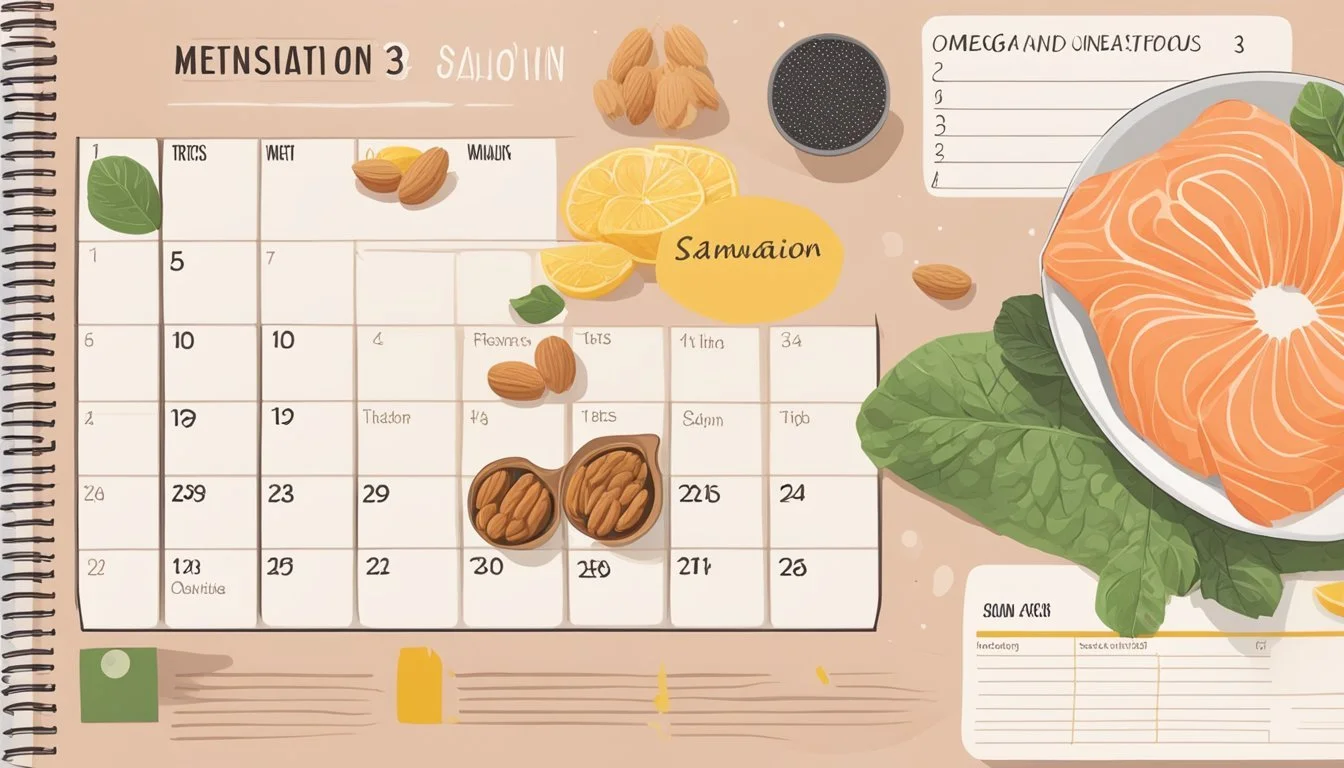11 Tips for Managing PTSD Symptoms During Menstruation
Practical Strategies for Relief
Managing PTSD symptoms can be challenging, especially for those who experience hormonal fluctuations during their menstrual cycle. Research has shown that symptoms of post-traumatic stress disorder can vary throughout the menstrual cycle, with some phases exacerbating the condition.
Understanding the connection between hormonal changes and PTSD can empower individuals to adopt effective strategies for symptom management. This article provides practical tips for navigating this complex interaction, helping individuals maintain a better quality of life during their menstrual cycle.
1) Track your cycle with a period app
Managing PTSD symptoms during menstruation can be more effective when one understands their menstrual cycle. Using a period tracker app helps in predicting the onset of the menstrual period, which can aid in preparing for the physical and emotional changes that might exacerbate PTSD symptoms.
Period tracker apps are designed to monitor the cycle, fertility, and PMS symptoms accurately. Apps like those recommended by ob-gyns on Prevention and Women's Health Magazine can provide valuable insights.
These apps often come with features that allow users to log symptoms, mood changes, and stress levels. This detailed tracking can highlight patterns, helping individuals to understand when they might be more vulnerable to PTSD triggers.
Some apps also offer educational content about menstrual health, and personalized tips for managing symptoms. This can be particularly helpful for those dealing with PTSD, as it equips them with knowledge and strategies tailored to their specific needs.
Using a period tracker app also aids in communication with healthcare providers. Sharing precise data about the menstrual cycle and associated symptoms can lead to better support and tailored treatment plans. Apps reviewed by Healthnews are known for their accuracy and ease of use.
By implementing a reliable period tracker app, individuals can gain greater control over their menstrual cycle and better manage PTSD symptoms.
2) Practice Mindfulness Meditation
Mindfulness meditation can help manage PTSD symptoms during menstruation by promoting relaxation and reducing stress.
When practicing mindfulness, individuals focus on the present moment, which can alleviate anxiety and intrusive thoughts.
Meditation also encourages deep breathing, aiding in the reduction of physical discomfort such as cramps.
Hormonal changes during menstruation can exacerbate PTSD symptoms. Meditation can mitigate these effects by stabilizing mood.
Mindfulness can also help identify patterns in physical and emotional responses throughout the menstrual cycle, providing better self-awareness.
Practicing mindfulness regularly can empower individuals to take control over their symptoms and improve overall well-being.
For a structured mindfulness practice, one might consider guided meditations or breathing exercises. These can be done by sitting or lying down in a comfortable position.
For additional information on mindfulness and mediation during menstruation, check out Mindfulness Can Transform Your Period and Mindfulness for Menstruation.
3) Engage in gentle yoga
Engaging in gentle yoga can provide significant relief for those managing PTSD symptoms during menstruation. Yoga offers a mindful way to reduce stress and physical discomfort.
Specific poses like Child's Pose and Head-to-Knee Pose are particularly effective. These positions are designed to alleviate menstrual cramps, backaches, and bloating.
Adding props, such as yoga blocks or folded blankets, can make these poses even more comfortable. Small adjustments can make a big difference, ensuring that the practice remains soothing rather than strenuous.
Including a regular yoga practice helps enhance body awareness and emotional balance. This can be extremely helpful for emotional regulation, especially when combined with deep breathing techniques.
Also, avoid poses that might be too intense during menstruation, such as handstands or headstands. Instead, focus on what feels nurturing and supportive during this time.
Incorporating gentle yoga into a daily routine can create a calming space that mitigates both the physical and emotional challenges associated with PTSD and menstruation.
4) Stay Hydrated with Herbal Teas Like Chamomile
Staying hydrated is essential, especially during menstruation. Herbal teas like chamomile can be an excellent choice for hydration and soothing discomfort.
Chamomile tea is known for its calming effects, which can help reduce anxiety and promote relaxation. It can be particularly beneficial for those experiencing heightened stress or mood swings during their menstrual cycle.
Chamomile is also caffeine-free, making it a good option for those who need to avoid stimulants. Drinking it warm can provide additional comfort, easing menstrual cramps and promoting better sleep.
Additionally, chamomile tea may support digestive health, helping to alleviate bloating and gastrointestinal discomfort. This can be particularly helpful for individuals who experience digestive issues during their period.
For an extra boost, try combining chamomile with other herbal teas like peppermint, which supports immune health. Peppermint contains menthol, which can soothe the stomach and respiratory system.
When preparing chamomile tea, use one or two teabags or teaspoons of dried chamomile flowers. Steep in hot water (around 90°C/194°F) for a few minutes, then strain. Enjoy it hot or cold, depending on your preference.
Staying hydrated with herbal teas can offer both physical and emotional benefits during menstruation, making it easier to manage PTSD symptoms.
5) Utilize Heating Pads for Cramps
Heating pads provide a simple yet effective solution for menstrual cramps. Applying heat to the lower abdomen can relax muscles and improve blood flow, alleviating pain. Many women find that consistent use brings significant relief.
There are various types of heating pads available. Some are electric, featuring adjustable temperature controls, while others are microwaveable and portable. This makes them convenient for use at home or on the go.
Experts recommend using heating pads for 10-30 minutes at a time. This duration is sufficient to provide comfort without applying excessive heat. Utilizing a heating pad two to three times a day can help manage severe cramps.
When selecting a heating pad, consider options like those reviewed by doctors and users on reputable sites. For instance, the selection at Prevention offers a variety of highly-rated products.
For added convenience, there are disposable heating patches that stick directly to the skin. These are particularly useful for those with busy schedules. Options like the Lola Menstrual Cramp Heating Patch, highlighted by Allure, provide targeted relief.
Always follow the manufacturer's instructions for safe use. This ensures effective pain management without complications, making heating pads a reliable choice for managing period-related discomfort.
6) Incorporate Omega-3 Rich Foods
Including omega-3 rich foods in the diet can be beneficial for managing PTSD symptoms, particularly during menstruation. Omega-3 fatty acids are known for their anti-inflammatory properties and their potential to support mental health.
Fatty fish like salmon, mackerel, and sardines are excellent sources of omega-3 fatty acids. Aim to include these fish in meals two to three times a week. They can be grilled, baked, or added to salads and other dishes.
For those who prefer plant-based options, flaxseeds, chia seeds, and walnuts are great alternatives. Ground flaxseeds can be sprinkled over oatmeal or yogurt, while chia seeds can be added to smoothies. Walnuts make for a healthy snack or a crunchy salad topper.
Another source of omega-3s is seaweed and algae. This is especially useful for vegans and vegetarians. These can be found in various forms, such as seaweed snacks or algae-based supplements.
Including a variety of omega-3 rich foods in the diet can help support overall mental well-being and may alleviate some symptoms associated with PTSD. For those looking to supplement their intake, fish oil or algae-based supplements are an option.
For more details on incorporating these foods into your diet, visit the Harvard article on omega-3 foods.
7) Avoid caffeine and refined sugars
Caffeine and refined sugars can heighten anxiety and stress levels. This is particularly problematic for individuals managing PTSD symptoms during menstruation. Avoiding these substances can bring noticeable benefits.
Caffeine, found in coffee, tea, and many sodas, can disrupt sleep patterns. Insufficient sleep can worsen PTSD symptoms, making it difficult to cope with emotional stress.
Refined sugars, prevalent in sweets and processed foods, can cause blood sugar spikes and crashes. These fluctuations can exacerbate mood swings and irritability, which are already challenging during menstruation.
Choosing healthier alternatives like herbal teas, whole fruits, and nuts can help maintain stable energy levels. Opting for complex carbohydrates and proteins can provide sustained energy without the negative effects of caffeine and refined sugars.
Moreover, removing these from your diet might reduce physical symptoms like bloating and cramps. This reduction in physical discomfort can further help manage PTSD symptoms.
For those struggling to eliminate caffeine and refined sugars, gradually reducing intake can be an effective strategy. This step-by-step approach can make the transition smoother and more sustainable.
8) Journal your feelings and symptoms
Journaling can be a powerful tool for managing PTSD symptoms during menstruation. By putting pen to paper, individuals can process emotions more effectively. This straightforward practice helps in identifying patterns and triggers related to their menstrual cycle.
Psychologically, expressive writing aids in coping with PTSD-related anxiety and anger. Physically, it has been shown to reduce body tension and promote focus. Regular journaling sessions can help track mood changes and symptoms, offering valuable insights for better self-care.
In addition, journaling may help reduce stress, anxiety, and depression. It provides a safe space to express and reflect on one's feelings. This practice can be tailored with specific writing prompts to address mental health, as suggested by therapists.
To get started, it's helpful to choose a quiet time each day dedicated to journaling. Writing about daily experiences and emotions can help in recognizing any changes or stressors. Establishing this habit can enhance emotional awareness and resilience.
For those coping with PTSD, maintaining a journal can be a vital part of their strategy. It encourages mindfulness and allows for a better understanding of how menstruation impacts their mental health.
9) Practice Deep Breathing Exercises
Deep breathing exercises can play a vital role in managing PTSD symptoms, especially during menstruation. These exercises help in alleviating anxiety and stress by promoting relaxation.
When anxiety spikes, breathing patterns may become irregular. Techniques like diaphragmatic breathing can help regulate these patterns. Inhaling deeply through the nose, holding for a few seconds, and exhaling slowly through the mouth can be very effective.
Incorporating deep breathing into a daily routine can significantly reduce stress levels. Regular practice enhances the body's natural relaxation response. Even just a few minutes of focused breathing can provide instant relief.
There are various breathing techniques that one can explore. These can include paced breathing, where one maintains a consistent inhale-exhale rhythm, or box breathing, which involves holding each breath for a few seconds.
Deep breathing can be practiced anywhere and at any time, making it a convenient tool for those experiencing PTSD symptoms during menstruation. It can be particularly helpful during moments of heightened stress or panic.
Utilizing resources like breathing exercises for PTSD management can provide additional strategies and support.
10) Ensure a consistent sleep schedule
Maintaining a regular sleep schedule can significantly help manage PTSD symptoms during menstruation. Going to bed and waking up at the same time every day, even on weekends, helps regulate the body’s internal clock, making it easier to fall asleep and wake up feeling refreshed.
Creating a bedtime routine is important. This might include activities like reading a book, taking a warm bath, or practicing mindfulness exercises.
Reducing screen time before bed is also beneficial as the blue light from devices can interfere with the production of melatonin, the hormone that regulates sleep.
Make sure the sleep environment is conducive to rest. A cool, dark, and quiet room can drastically improve sleep quality. Using blackout curtains and white noise machines might be helpful.
Avoiding caffeine and large meals before bedtime can further promote better sleep. Both can disrupt the body's ability to transition into a restful sleep state.
By ensuring consistency with these habits, individuals can experience improved sleep quality, which may alleviate some PTSD symptoms during menstruation. More practical advice can be found on sleep hygiene for PTSD.
11) Seek support from a therapist
Talking to a therapist can provide essential support for managing PTSD symptoms during menstruation.
A therapist can help identify and address specific triggers related to menstruation. Understanding these triggers can be a significant step toward managing symptoms effectively.
Therapists can teach coping mechanisms and strategies designed to alleviate stress and anxiety. These techniques can be invaluable in maintaining mental well-being during your menstrual cycle.
Professional help also includes exploring and adapting to various treatment options. For example, you can learn about the benefits of cognitive-behavioral therapy (CBT) for PTSD.
Establishing a supportive relationship with a therapist can provide a safe space for expressing feelings and concerns. This emotional support is crucial for long-term recovery and symptom management.
Regular therapy sessions can also help track progress and make necessary adjustments to treatment plans. This can optimize outcomes and provide personalized care.
Consulting with a therapist ensures professional, evidence-based approaches are implemented. This contributes to effective symptom management and improved quality of life.
Reaching out to a therapist is a proactive step toward gaining control over PTSD symptoms. Professional guidance can make a substantial difference in handling the added challenges during menstruation.
Understanding the Connection Between PTSD and Menstruation
Research has shown that the menstrual cycle can significantly influence PTSD symptoms. Hormonal changes and emotional triggers play crucial roles in this interaction.
Hormonal Changes and PTSD Symptoms
Hormonal fluctuations throughout the menstrual cycle impact PTSD symptoms. Estrogen and progesterone levels vary during different phases, affecting mood and stress response.
Studies indicate that symptoms like anxiety, irritability, and depression can worsen during low estrogen phases. The hypothalamic-pituitary-adrenal (HPA) axis also links hormonal changes to stress regulation, influencing PTSD symptoms.
These hormonal shifts can exacerbate PTSD, leading to increased sensitivity to stress. Understanding this connection is essential for managing symptoms effectively.
Menstrual Cycle and Emotional Triggers
The menstrual cycle can amplify emotional triggers in individuals with PTSD. Emotional sensitivity often increases during the premenstrual and menstrual phases.
A study found that PTSD-like symptoms can fluctuate notably during these times. Women may experience heightened irritability, sadness, or anger, linked to hormonal influences.
Recognizing these emotional patterns allows for better preparation and coping strategies. Awareness of these triggers enables individuals to manage their PTSD symptoms more effectively during menstruation.
Psychological Strategies to Manage PTSD During Menstruation
During menstruation, fluctuations in hormones can exacerbate PTSD symptoms, making it crucial to adopt effective psychological strategies. Key techniques include practicing mindfulness and meditation and utilizing cognitive behavioral methods.
Mindfulness and Meditation
Mindfulness involves staying present and aware of the current moment without judgment. Guided meditations or mindfulness exercises can help manage stress and anxiety associated with PTSD.
Meditation practices, such as deep breathing and progressive muscle relaxation, also help in reducing cortisol levels, promoting a sense of calm. Practicing mindfulness consistently may lead to improved emotional regulation and reduced symptom severity. Apps and online resources can be valuable tools for those new to mindfulness techniques.
Cognitive Behavioral Techniques
Cognitive Behavioral Techniques (CBTs) focus on altering negative thought patterns that contribute to PTSD symptoms. These techniques include cognitive restructuring, which helps individuals reframe their thoughts to be more realistic and less distressing.
Exposure therapy within CBT can also aid in gradually confronting and desensitizing triggers related to trauma. Keeping a journal to track thoughts and symptoms can support the integration of CBT practices into daily routines. Working with a trained therapist often enhances the effectiveness of CBT for managing PTSD during menstruation.
The Role of Nutrition and Exercise
Managing PTSD symptoms during menstruation can benefit from targeted dietary adjustments and gentle physical activities. These strategies help maintain mental well-being and reduce physical discomfort.
Dietary Adjustments to Alleviate Symptoms
A balanced diet rich in nutrients can significantly impact mental health. Incorporating foods high in omega-3 fatty acids, like salmon and walnuts, can aid in reducing inflammation and improving mood.
Whole grains, such as brown rice and quinoa, provide a steady source of energy, helping to maintain stable blood sugar levels. This can prevent mood swings and fatigue.
Antioxidants found in fruits and vegetables, especially dark leafy greens and berries, can protect against oxidative stress, which is often heightened in individuals with PTSD.
Avoiding processed foods and excessive sugar is crucial. These can lead to short-term spikes in energy but result in subsequent crashes, exacerbating symptoms. Instead, focus on nutrient-dense snacks like nuts, seeds, and fresh fruit.
Gentle Physical Activities
Engaging in gentle physical activities can provide substantial benefits for those managing PTSD. Yoga has been specifically noted for its ability to center the mind and reduce stress. It teaches mindfulness and helps connect physical movements with breath control.
Walking, especially in nature, can offer a serene environment conducive to reducing anxiety and improving mood. It is less intense yet effective for enhancing cardiovascular health.
Stretching and gentle aerobic exercises, like swimming, can also be beneficial. They increase endorphin levels without placing excessive stress on the body, which can be particularly helpful during menstruation when energy levels might be lower.
Prioritizing consistent, manageable exercise routines can foster a sense of control and accomplishment, aiding in overall symptom management.












